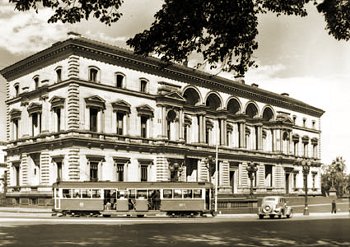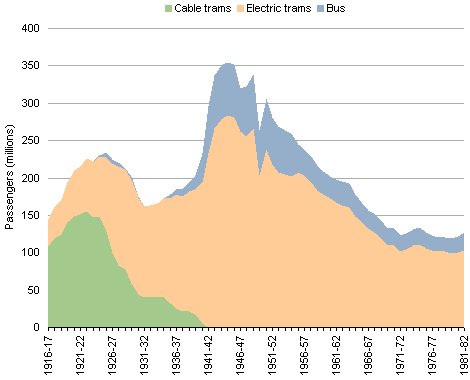Melbourne Tram Museum
- Follow Melbourne Tram Museum on Twitter
- Follow Melbourne Tram Museum on Facebook
- Follow Melbourne Tram Museum on Instagram
- Follow Melbourne Tram Museum on Pinterest
- Follow Melbourne Tram Museum on Tumblr
- Subscribe to Melbourne Tram Museum's RSS feed
- Email Melbourne Tram Museum
Fares please! An economic history of the Melbourne & Metropolitan Tramways Board
Post-war doldrums
The ending of the Second World War did not bring the opportunities that the M&MTB was expecting. Rationing continued, so materials were scarce, restricting the Board’s ability to implement expansion plans. The return of employees from war service saw most of the conductresses dismissed.
 W5 class tram in front of the Treasury Building at the intersection
of Spring, Collins and Macarthur Streets, 1945.
W5 class tram in front of the Treasury Building at the intersection
of Spring, Collins and Macarthur Streets, 1945. - Photograph courtesy National Archives of Australia.
In 1948-49 the M&MTB cancelled 47% of its outstanding loans, massively reducing the yearly interest bill. Despite this initiative, it was consistently running large deficits as from the previous financial year. However, capital expenditure was increasing to pre-war levels, remedying the lack of investment in the system.
A major area of investment was in the expansion and upgrading of Preston Workshops. Construction of further SW6 tramcars continued, and the 31-seat Leyland buses ordered in 1941 but delayed by the war were finally delivered. As the new tramcars were being delivered, the opportunity was taken to dispose of the maximum traction tramcars, most of which were sold to the SECV for service in Geelong, Ballarat and Bendigo.
A tramcar set of electrical and traction equipment of the PCC type was ordered from the United States, after a two-year delay waiting to receive a Customs Import Licence due to the exchange controls placed on US dollar trading. This equipment was received in 1949, and was placed under a locally built body based on the SW6 design, entering service in 1950 as number 980. This car was to be the prototype for the planned Bourke Street trams, but the refusal of the Federal Government to grant licences for import of additional equipment would mean that these cars would instead be variations of the standard Melbourne W tramcar.
Planning for the conversion of the former Bourke Street cable lines was well underway by 1946, and all the rails ordered for this work from BHP were delivered. The first automatic point changer in Melbourne was installed at the corner of William and Peel Streets in 1946. This was a significant step towards reduction in staffing requirements through elimination of signalmen.
Passenger numbers dropped to a post-war low in 1946-47 before trending upwards again over the following two years. This was subsequently followed by a sharp drop as a result of a week long industrial dispute in 1949-50. Local production of the Holden motorcar did not commence until 1948, and even then numbers were limited. Similarly motorcar imports were also restricted, thus public transport was still the dominant method of travel used by the citizens of Melbourne.
 Annual passengers, 1916-17 to 1981-82.
Annual passengers, 1916-17 to 1981-82. - Source M&MTB.